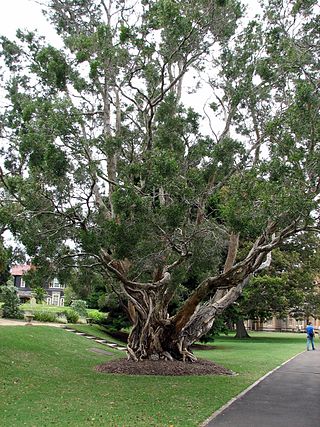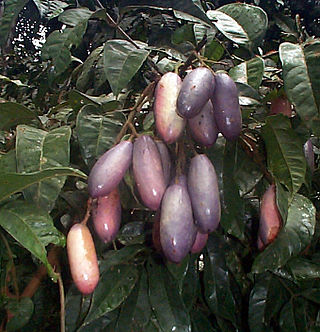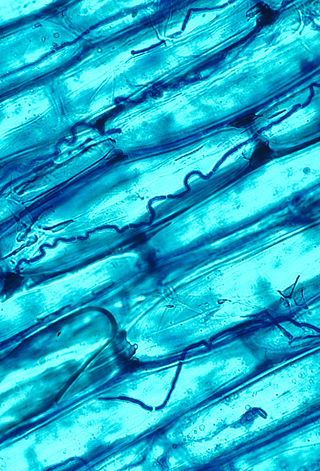
Melaleuca is a genus of nearly 300 species of plants in the myrtle family, Myrtaceae, commonly known as paperbarks, honey-myrtles or tea-trees. They range in size from small shrubs that rarely grow to more than 16 m (52 ft) high, to trees up to 35 m (115 ft). Their flowers generally occur in groups, forming a "head" or "spike" resembling a brush used for cleaning bottles, containing up to 80 individual flowers.

An essential oil is a concentrated hydrophobic liquid containing volatile chemical compounds from plants. Essential oils are also known as volatile oils, ethereal oils, aetheroleum, or simply as the oil of the plant from which they were extracted, such as oil of clove. An essential oil is essential in the sense that it contains the essence of the plant's fragrance—the characteristic fragrance of the plant from which it is derived. The term "essential" used here does not mean indispensable or usable by the human body, as with the terms essential amino acid or essential fatty acid, which are so called because they are nutritionally required by a living organism.

Mycobacterium is a genus of over 190 species in the phylum Actinomycetota, assigned its own family, Mycobacteriaceae. This genus includes pathogens known to cause serious diseases in mammals, including tuberculosis and leprosy in humans. The Greek prefix myco- means 'fungus', alluding to this genus' mold-like colony surfaces. Since this genus has cell walls with a waxy lipid-rich outer layer that contains high concentrations of mycolic acid, acid-fast staining is used to emphasize their resistance to acids, compared to other cell types.

Boletus edulis is a basidiomycete fungus, and the type species of the genus Boletus. Widely distributed in the Northern Hemisphere across Europe, Asia, and North America, it does not occur naturally in the Southern Hemisphere, although it has been introduced to southern Africa, Australia, New Zealand, and Brazil. Several closely related European mushrooms formerly thought to be varieties or forms of B. edulis have been shown using molecular phylogenetic analysis to be distinct species, and others previously classed as separate species are conspecific with this species. The western North American species commonly known as the California king bolete is a large, darker-coloured variant first formally identified in 2007.

Tea tree oil, also known as melaleuca oil, is an essential oil with a fresh, camphoraceous odor and a colour that ranges from pale yellow to nearly colourless and clear. It is derived from the leaves of the tea tree, Melaleuca alternifolia, native to southeast Queensland and the northeast coast of New South Wales, Australia. The oil comprises many constituent chemicals, and its composition changes if it is exposed to air and oxidizes. Commercial use of tea tree oil began in the 1920s, pioneered by the entrepreneur Arthur Penfold. As of 2017 the global tea tree oil market was valued at US$39 million.

An endophyte is an endosymbiont, often a bacterium or fungus, that lives within a plant for at least part of its life cycle without causing apparent disease. Endophytes are ubiquitous and have been found in all species of plants studied to date; however, most of the endophyte/plant relationships are not well understood. Some endophytes may enhance host growth, nutrient acquisition and improve the plant's ability to tolerate abiotic stresses, such as drought and decrease biotic stresses by enhancing plant resistance to insects, pathogens and herbivores. Although endophytic bacteria and fungi are frequently studied, endophytic archaea are increasingly being considered for their role in plant growth promotion as part of the core microbiome of a plant.

Cajeput tree is a common name used for certain classification of tree that has a white spongy bark that is flexible and can easily flake off the trunk. The Cajeput tree is of the genus Melaleuca, native to Australia and is commonly known in North America as the tea tree. The name "Cajeput tree" is primarily used for the species M. cajuputi, M. leucadendra, M. linariifolia, M. viridiflora and M. quinquenervia. Other names for these trees are the paperbark tree, punk tree, or the white bottle brush tree. Similar subtropical trees from the eucalyptus family are evergreens with pointed leaves and white, red or green flowers.

Backhousia citriodora is a flowering plant in the family Myrtaceae, genus Backhousia. It is endemic to subtropical rainforests of central and south-eastern Queensland, Australia, with a natural distribution from Mackay to Brisbane.

Melaleuca alternifolia, commonly known as tea tree, is a species of tree or tall shrub in the myrtle family, Myrtaceae. Endemic to Australia, it occurs in southeast Queensland and the north coast and adjacent ranges of New South Wales where it grows along streams and on swampy flats, and is often the dominant species where it occurs.

Camellia oleifera, which originated in China, is notable as an important source of edible oil obtained from its seeds. It is commonly known as the oil-seed camellia or tea oil camellia, though to a lesser extent other species of camellia are used in oil production too.
Terpinen-4-ol is an isomer of terpineol with the chemical formula C10H18O. A primary constituent of tea tree oil, it is obtained as an extract from the leaves, branches, and bark of Melaleuca alternifolia Cheel. Despite considerable basic and preliminary clinical research of terpinen-4-ol and tea tree oil, its biological properties and potential for clinical uses have not been established as of 2019. It may be a factor in the contact dermatitis of tea tree oil when used topically.

Melaleuca quinquenervia, commonly known as the broad-leaved paperbark, paper bark tea tree, punk tree or niaouli, is a small- to medium-sized tree of the myrtle family, Myrtaceae. It grows as a spreading tree up to 20 m (70 ft) tall, with its trunk covered by a white, beige and grey thick papery bark. The grey-green leaves are egg-shaped, and cream or white bottlebrush-like flowers appear from late spring to autumn. It was first formally described in 1797 by the Spanish naturalist Antonio José Cavanilles.

Dacryodes edulis is a fruit tree in the Burseraceae family native to Africa. Its various regional names include safou, plum (Cameroon), atanga, ube, elumi (Nigeria), African pear, bush pear, African plum, nsafu, bush butter tree, or butterfruit.

Isocitrate lyase, or ICL, is an enzyme in the glyoxylate cycle that catalyzes the cleavage of isocitrate to succinate and glyoxylate. Together with malate synthase, it bypasses the two decarboxylation steps of the tricarboxylic acid cycle and is used by bacteria, fungi, and plants.

In enzymology, a malate synthase (EC 2.3.3.9) is an enzyme that catalyzes the chemical reaction

Allophylus edulis is a plant species in the genus Allophylus endemic to the Guianas, Brazil, Bolivia, Paraguay, Argentina and Uruguay.

Oxyops vitiosa is a species of weevil in the family Curculionidae. Common names include the melaleuca leaf weevil and the melaleuca snout beetle. It feeds on the leaves and shoots of the broad-leaved paper bark tree, Melaleuca quinquenervia, which is endemic to Australia where it grows on seasonally inundated plains and swampland, and was introduced into Florida in order to help drain flooded portions of the Everglades.

Plant use of endophytic fungi in defense occurs when endophytic fungi, which live symbiotically with the majority of plants by entering their cells, are utilized as an indirect defense against herbivores. In exchange for carbohydrate energy resources, the fungus provides benefits to the plant which can include increased water or nutrient uptake and protection from phytophagous insects, birds or mammals. Once associated, the fungi alter nutrient content of the plant and enhance or begin production of secondary metabolites. The change in chemical composition acts to deter herbivory by insects, grazing by ungulates and/or oviposition by adult insects. Endophyte-mediated defense can also be effective against pathogens and non-herbivory damage.

Secalonic acids are a group of xanthone derivatives closely related to ergoflavin and ergochrysin A that are collectively called ergochromes and belong to a class of mycotoxins initially isolated as major ergot pigments from the fungi Claviceps purpurea that grows parasitically on rye grasses. From early times and particularly in medieval Europe the consumption of grains containing ergot has repeatedly lead to mass poisonings known as ergotism which was caused by toxic ergot alkaloids and mycotoxins such as the ergochromes, due to contamination of flour by C. purpurea. A cluster of genes responsible for the synthesis of secalonic acids in C. purpurea has been identified. Secalonic acid D the enantiomer of secalonic acid A is a major environmental toxin, isolated from the fungus Penicillium oxalicum, and is a major microbial contaminant of freshly-harvested corn which causes toxicity through contamination of foodstuffs.

Fellutamides are tripeptide derivatives from Penicillium fellutanum and other fungi. They are potent proteasome inhibitor that stimulates nerve growth factor synthesis in vitro.




















